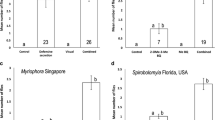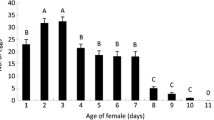Summary
Six benzylisoquinoline alkaloids were fed to the larvae of three polyphagous Lepidoptera species: Hyphantria cunea, Spodoptera eridania, and Lymantria dispar. Exposure of last instar larvae to alkaloid-containing diets over a 24-h period resulted in reduced feeding rates and reduced growth efficiencies. Lymantria dispar larvae reared from eggs on alkaloid diets took longer to reach the fifth instar, attained lower larval weights, and showed reduced survivorship. The benzylisoquinolines tested were not equally effective as toxins or feeding inhibitors. Some produced dramatic effects while others produced no effects. The relative responses of the three caterpillar species to the six alkaloids were similar. Those benzylisoquinolines with a methylene-dioxyphenyl (1,3-benzodioxole) group were consistently the most toxic or repellent while laudanosine, a relatively simple benzylisoquinoline, was generally innocuous. Available host records indicate that benzylisoquinoline-containing plants are avoided by the larvae of these moth species.
Similar content being viewed by others
References
Barbosa P (1978) Host plant exploitation by the gypsy moth, Lymontria dispar. Entomol Exp Appl 24:228–237
Beck SD (1974) Theoretical aspects of host plant specificity in insects. In: Maxwell FG, Harris FA (eds) Proc Inst on Biological Control of Plant Insects and Diseases. Univ Mississippi Press, Jackson, pp 290–311
Beck SD, Reese JC (1976) Insect-plant interactions: nutrition and metabolism. In: Wallace JW, Mansell RL (eds) Biochemical interaction between plants and insects. Rec Adv Phytochem 10:41–92
Berenbaum M, Feeny P (1981) Toxicity of angular furanocoumarins to swallowtail butterflies: escalation in a coevolutionary arms race? Science 212:927–929
Bernays EA, Chapman RF (1977) Deterrent chemicals as a basis of oligophagy in Locusta migratoria (L.). Ecol Entomol 2:1–18
Blau PA, Feeny P, Contardo L, Robson DS (1978) Allylglucosinolate and herbivorous caterpillars: a contrast in toxicity and tolerance. Science 200:1296–1298
Blau WS (1981) Life history variation in the black swallowtail butterfly. Oecologia (Berlin) 48:116–122
Brattsten LB (1979) Biochemical defense mechanisms in herbivores against plant allelochemicals. In: Rosenthal GA, Janzen DH (eds) Herbivores: their interaction with secondary plant metabolites. Academic Press, New York, pp 200–262
Buhr H, Tobal R, Schreiber K (1958) Die Wirkung von einigen pflanzlichen Sonderstoffen, insbesondere von Alkaloiden, auf die Entwicklung der Larven des Kartoffelkäfers (Leptinotarsa decemlineata) Say. Entomol Exp Appl 1:209–224
Dolinger PM, Ehrlich PR, Fitch WL, Breedlove DE (1973) Alkaloid and predation patterns in Colorado lupine populations. Oecologia (Berlin) 13:191–204
Doskotch RW, El-Feraly FS, Fairchild EH, Huang C (1977) Isolation and characterization of peroxyferolide, a hydroperoxy sesquiterpene lactone from Liriodendron tulipifera. J Org Chem 42:3614–3618
Ehrlich PR, Raven PH (1964) Butterflies and plants: a study in coevolution. Evolution 18:586–608
Feeny P (1976) Plant apparency and chemical defense. In: Wallace JW, Mansell RL (eds) Biochemical interaction between plants and insects. Recent Adv Phytochem 10:1–40
Fraenkel GS (1969) Evaluation of our thoughts on secondary plant substances. Entomol Exp Appl 12:473–486
Harley KLS, Thorsteinson AJ (1967) The influence of plant chemicals on the feeding behavior, development and survival of the two-striped grasshopper, Melanoplus bivittatus (Say), Acrididae: Orthoptera. Can J Zool 45:305–319
Hedin PA, Maxwell FG, Jenkins JN (1974) Insect plant attractants, feeding stimulants, repellents, deterrents and other related factors affecting insect behavior. In: Maxwell FG, Harris FA (eds) Proc Inst on Biological Control of Plant Insects and Diseases. Univ Mississippi Press, Jackson, pp 494–527
Ishikawa S (1966) Electrical response and function of a bitter substance receptor associated with the maxillary sensilla of the larva of the silkworm, Bombyx mori L. J Cell Physiol 67:1–12
Janzen DH, Juster HB, Bell EA (1977) Toxicity of secondary compounds to the seed-eating larvae of the bruchid beetle Callosobruchus maculatus. Phytochemistry 16:223–227
Kametani T (1974) The chemistry of the isoquinoline alkaloids, vol 2. Kinkodo Publ Co, Sendai, Japan
Kirscher HW, Heed WB, Russell JS, Grove J (1967) Senita cactus alkaloids: their significance to Sonoran Desert Drosophila ecology. J Insect Physiol 13:1869–1874
Kogan M, Goeden RD (1971) Feeding and host-selection behavior of Lema trilineata daturaphila larvae (Coleoptera: Chrysomelidae). Ann Entomol Soc Am 64:1435–1448
Krieger RI, Feeny PP, Wilkinson CF (1971) Detoxication enzymes in the guts of caterpillars: an evolutionary answer to plant defenses? Science 172:579–580
Lederhouse RC (1981) The effect of female mating frequency on egg fertility in the black swallowtail, Papilio polyxenes asterius (Papilionidae). J Lepidop Soc 35:266–277
Levin DA (1976) Alkaloid-bearing plants: an ecogeographic perspective. Am Nat 110:261–284
Levin DA York BM (1978) The toxicity of plant alkaloids: an ecogeographic perspective. Biochem Syst Ecol 6:61–76
Levinson HZ (1976) The defensive role of alkaloids in insects and plants. Experientia 32:408–411
Ma WC (1969) Some properties of gustation in the larva of Pieris brassicae. Entomol Exp Appl 12:584–590
Moran N, Hamilton WD (1980) Low nutritive quality as defense against herbivores. J Theor Biol 86:247–254
Mosher FH (1915) Food plants of the gypsy moth in America. USDA Bull No 250, Washington DC,
Mothes K (1976) Secondary plant substances as materials for chemical high quality breeding in higher plants. In: Wallace JW, Mansell RL (eds) Biochemical interaction between plants and insects. Recent Adv Phytochem 10:385–402
Munakata K (1970) Insect antifeedants in plants. In: Wood DL, Silverstein RM, Nakajima M (eds) Control of insect behavior by natural products. Academic Press, New York, pp 179–187
ODell TM, Rollinson WD (1966) A technique for rearing the gypsy moth, Porthetria dispar, on an artificial diet. J Econ Entomol 59:741–742
Raffauf RF (1970) A handbook of alkaloids and alkaloid-containing plants. Wiley, New York
Rausher MD (1982) Population differentiation in Euphydryas editha butterflies: larval adaptation to different hosts. Evolution 36:581–590
Rhoades DF, Cates RG (1976) Toward a general theory of plant antiherbivore chemistry. In: Wallace JW, Mansell RL (eds) Biochemical interaction between plants and insects. Recent Adv Phytochem 10:168–213
Robinson T (1974) Metabolism and function of alkaloids in plants. Science 184:430–435
Robinson T (1979) The evolutionary ecology of alkaloids. In: Rosenthal GA, Janzen DH (eds) Herbivores: their interaction with secondary plant metabolites. Academic Press, New York, pp 413–448
Robinson T (1980) The organic constituents of higher plants. Cordus Press, North Amherst, Massachusetts
Rodman JE (1981) Divergence, convergence, and parallelism in phytochemical characters: the glucosinolate-myrosinase system. In: Young DA, Seigler DS (eds) Phytochemistry and angiosperm phylogeny. Praeger Publishers, New York, p 43–79
Schmeltz I (1971) Nicotine and other tobacco alkaloids. In: Jacobson M, Crosby DG (eds) Naturally occurring insecticides. Dekker, New York, pp 99–136
Schoonhoven LM (1972) Secondary plant substances and insects. In: Runeckles VC, Tso TC (eds) Structural and functional aspects of phytochemistry. Academic Press, New York, pp 197–224
Schoonhoven LM, Derksen-Koppers I (1973) Effects of secondary plant substances on drinking behavior in some Heteroptera. Entomol Exp Appl 16:141–145
Seigler DS (1977) Plant systematics and alkaloids. In: Manske RH (ed) The alkaloids, vol 16. Academic Press, New York, pp 1–81
Self LS, Guthrie FE, Hodgson E (1964) Adaptation of tobacco hornworms to the ingestion of nicotine. J Insect Physiol 10:907–914
Shamma M, Moniot JL (1978) Isoquinoline alkaloids research: 1972–1977. Plenum Press, New York
Slansky F, Feeny P (1977) Stabilization of the rate of nitrogen accumulation by larvae of the cabbage butterfly on wild and cultivated food plants. Ecol Monogr 47:209–228
Sokal RR, Rohlf FJ (1981) Biometry: the principles and practice of statistics in biological research, WH Freeman and Co, San Francisco
Soo Hoo CF (1963) Selection and utilization of food plants by the larvae of Prodenia eridania (Cramer), with additional utilization studies on the silkworm. PhD thesis, Univ Illinois, Urbana
Spenser ID (1966) Biosynthesis of the alkaloids related to norlaudanosoline. Lloydia 29:71–89
Taylor WI (1962) The structure and synthesis of liriodenine, a new type of isoquinoline alkaloid. Tetrahedron 14:42–45
Tietz HM (1972) An index to the described life histories, early stages, and hosts of the Macrolepidoptera of the continental United States and Canada. Allyn Museum of Entomology, Sarasota, Florida
Wada K, Munakata K (1968) Naturally occurring insect control chemicals: isoboldine, a feeding inhibitor, and occulolidine, an insecticide in the leaves of Cocculus trilobus DC. J Agric Food Chem 16:471–474
Waterman PG (1975) Alkaloids of the Rutaceae: their distribution and systematic significance. Biochem Syst Ecol 3:149–180
Whittaker RH, Feeny PP (1971) Allelochemics: chemical interactions between species. Science 171:757–770
Wilkinson CF (1976) Insecticide interactions. In: Wilkinson CF (ed) Insecticide biochemistry and physiology. Plenum Press, New York, pp 604–647
Willaman JJ, Schubert BG (1961) Alkaloid-bearing plants and their contained alkaloids. USDA Tech Bull 1234
Yamamoto RT, Fraenkel GS (1960) The specificity of the tobacco hornworm, Protoparce sexta, to solanaceous plants. Ann Entomol Soc Am 53:503–507
Author information
Authors and Affiliations
Rights and permissions
About this article
Cite this article
Miller, J.S., Feeny, P. Effects of benzylisoquinoline alkaloids on the larvae of polyphagous Lepidoptera. Oecologia 58, 332–339 (1983). https://doi.org/10.1007/BF00385232
Received:
Issue Date:
DOI: https://doi.org/10.1007/BF00385232




